Bhagavad Gita › Bhubaneshwar › Magic in Ancient Egypt » Origins and History
Articles and Definitions › Contents
- Bhagavad Gita › Origins
- Bhubaneshwar › Origins
- Magic in Ancient Egypt › Origins
Ancient civilizations › Historical places, and their characters
Bhagavad Gita › Origins
Definition and Origins
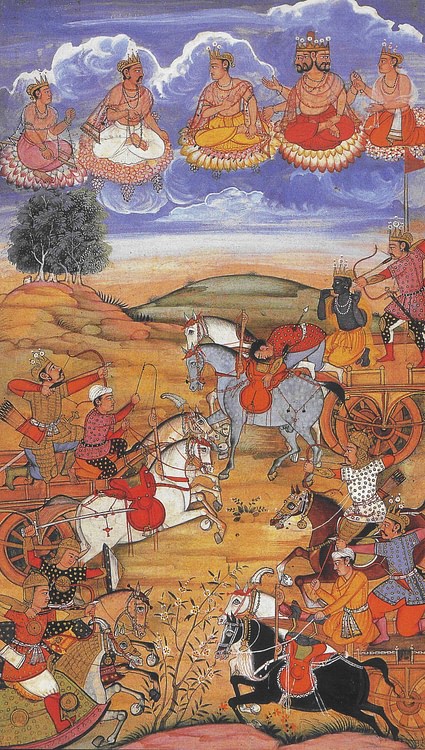
The Bhagavad Gita is an ancient Indian text that became an important work of Hindu tradition in terms of both literature and philosophy. The earliest translations of this work from Sanskrit into English were made around 1795 CE by Sir Charles Wilkins. The name Bhagavad Gita means “the song of the Lord”. It is composed as a poem and it contains many key topics related to the Indian intellectual and spiritual tradition. Although it is normally edited as an independent text, the Bhagavad Gitabecame a section of a massive Indian epic named “The Mahabharata ”, the longest Indian epic. There is a part in the middle of this long text, consisting of 18 brief chapters and about 700 verses: this is the section known as the Bhagavad Gita. It is also referred to as the Gita, for short.
AUTHORSHIP & ORIGIN
The Bhagavad Gita was written at some point between 400 BCE and 200 CE. Like the Vedas and the Upanishads, the authorship of the Bhagavad Gita is unclear. However, the credit for this text is traditionally given to a man named Vyasa, who is more of a legend than an actual historical figure; because of this, Vyasa has been compared to Homer, the great figure of ancient Greek epic poetry.
It has been suggested that the Bhagavad Gita was originally an independent text as, except for the first chapter, the Bhagavad Gita does not develop the action of the Mahabharata. Furthermore, the Bhagavad Gita is at odds with the general style and content of the Mahabharata. Once the Gita is over, the narration of the Mahabharata resumes.
The Gita was written during a time of important social change in India, with kingdoms getting larger, increasing urbanization, more trade activity, and social conflict similar to what was happening when Jainism and Buddhism developed. This ancient Indian text is about the search for serenity, calmness, and permanence in a world of rapid change and how to integrate spiritual values into ordinary life.
THEME, PLOT, & SETTING
Around the time when the Gita was written, asceticism was seen in India as the ideal spiritual life. Ascetics from different sects along with Jains and Buddhists all agreed that leaving everything behind (family, possessions, occupations, etc.) was the best way to live in a meaningful way.
YOU WERE NEVER BORN; YOU WILL NEVER DIE. YOU HAVE NEVER CHANGED; YOU CAN NEVER CHANGE.BHAGAVAD GITA
The Bhagavad Gita revolves around the following questions: How can someone live a life spiritually meaningful without withdrawing from society? What can someone who does not want to give up family and social obligations do to live the right way? The Gita challenges the general consensus that only ascetics and monks can live a perfect spiritual life through renunciation and emphasises the value of an active spiritual life.
The plot of the Gita is based on two sets of cousins competing for the throne: The Pandavas and the Kauravas. Diplomacy has failed, so these two clans' armies meet on a battlefield in order to settle the conflict and decide which side will gain the throne. This is a major battle and it takes place in Kurukshetra, “the field of the Kurus”, in the modern state of Haryana in India.
Arjuna, the great archer and leader of the Pandavas, is a member of the Kshatriyas caste (the warrior rulers caste). He looks out towards his opponents and recognizes friends, relatives, former teachers, and finally reasons that controlling the kingdom is not worth the blood of all his loved ones. Emotionally overwhelmed, Arjuna drops down, casting aside his bow and arrows and decides to quit. He prefers to withdraw from battle; he prefers inaction instead of being responsible for the death of the people he loves.
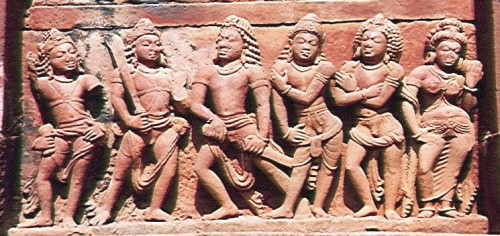
Pandavas
His chariot driver is the god Vishnu, who has taken the form of Krishna. Krishna sees Arjuna quitting and begins to persuade Arjuna that he should stick to his duty as a warrior and engage the enemy. The Bhagavad Gita is presented as a conversation between Arjuna and Krishna, a man and a god, a seeker and a knower.
THE MESSAGE OF THE BHAGAVAD GITA
Arjuna is worried about entering the battle and destroying his own family, so Krishna begins by explaining five reasons why Arjuna should not be troubled by this. Essentially Krishna shows Arjuna why he will not get bad karma from taking part in the war.
The first reason Krishna mentions is that because atman (the self) is eternal, it is a mistake to think that one can actually kill someone. What actually happens is that people are sent to the next stage of reincarnation.
[Krishna speaking] One believes he is the slayer, another believes he is the slain. Both are ignorant; there is neither slayer nor slain. You were never born; you will never die. You have never changed; you can never change. Unborn, eternal, immutable, immemorial, you do not die when the body dies. ( Bhagavad Gita 2:19-20)
Another reason why Arjuna should fight is because of honour and duty, also referred to as dharma or cast duty. Arjuna is a member of the warrior class; the battle is the very reason of his existence. It is not sinful to fulfil your duty in life.
The third reason Krishna gives is that inaction is impossible. Withdrawing from battle is in itself a conscious decision; not choosing is still a choice. This is in a way a criticism of some world-views, such as asceticism, which claim that leaving everything behind is inaction: Withdrawing from society is always a deliberate act.
Another reason given by Krishna is that the source of evil is not in actions, but in passion and desires, the intentions behind the actions. This brings the dialogue to the last reason.
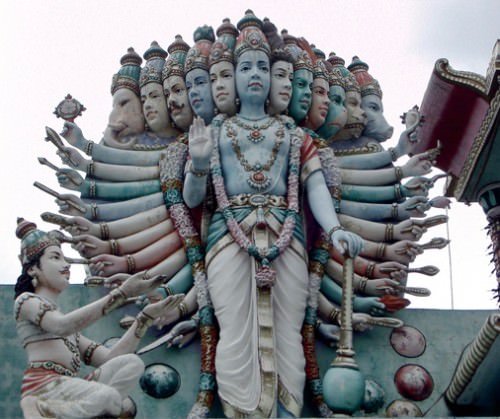
Krishna manifesting his full glory to Arjuna
The fifth and last reason is that there are ways to act where we can do what we have to do without getting bad karma. In the Bhagavad Gita, Krishna explains three ways.
The first way is Jnana yoga (the way of knowledge). This idea is based on the Upanishads and holds that life and death are not real. Selfhood is nothing but an illusion. All we see are manifestations of the oneness. Once we realize that the oneness is behind all things, we can escape the bad karma from acting.
[Krishna speaking] I am ever present to those who have realized me in every creature. Seeing all life as my manifestation, they are never separated from me. ( Bhagavad Gita 6:30)
The second way is Bhakti yoga (the way of devotion). This in an idea developed in great detail in Hinduism and holds that our actions can be dedicated to Krishna by surrendering our will to him, and he will take upon himself any bad karma.
The third way is Karma yoga (“the way of action” or “the way of works”). The idea behind Karma yoga is acting without attachment; in other words, to act without being so concerned about the outcome of our actions. According to this view, if we act in such a way as not to get attached to the fruits of our actions, we can be more effective. Sometimes emotions like fear, embarrassment, or anxiety can interfere in the outcome of what we do.
[Krishna speaking] Neither agitated by grief nor hankering after pleasure, they live free from lust and fear and anger. Established in meditation, they are truly wise. Fettered no more by selfish attachments, they are neither elated by good fortune nor depressed by bad. Such are the seers." ( Bhagavad Gita 2:56-57)[Krishna speaking] Thinking of objects, attachment to them is formed in a man. From attachment longing, and from longing anger grows. From anger comes delusion, and from delusion loss of memory. From loss of memory comes the ruin of understanding, and from the ruin of understanding he perishes. ( Bhagavad Gita 2:62-63)
Each of these three ways to act without getting bad karma is suitable for different people or castes. Priests would follow the way of knowledge; peasants, merchants and commoners might be inclined to the way of devotion; warriors would identify themselves with the way of action. Finally, Arjuna decides to obey Krishna by engaging in the battle and in the end the Pandavas regain control of the kingdom.
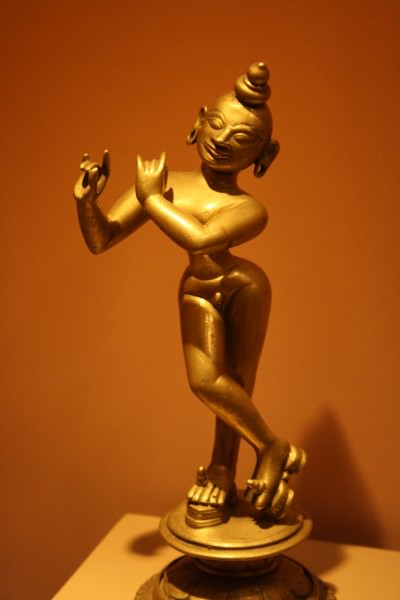
Krishna
THE INFLUENCE OF THE BHAGAVAD GITA
No other Indian text has attracted more attention from foreigners than the Bhagavad Gita. Important figures such as Mahatma Gandhi held the Gita as their main reference book.
The physicist Robert Oppenheimer watched the massive explosion and blinding flash of the mushroom cloud of the first atomic bomb test in New Mexico. Oppenheimer then claimed that when he saw that, two verses from the Gita came to his mind:
If a thousand suns were to raise in the heavens at the same time, the blaze of their light would resemble the splendor of that supreme spirit. ( Bhagavad Gita 11:12)
I am time, the destroyer of all; I have come to consume the world [...]. ( Bhagavad Gita 11:32)
This ancient book which contains a message that could be considered either distressing or inspiring still addresses some of the concerns we have today, and its message has spread all over Asia and across the globe.
Bhubaneshwar › Origins
Definition and Origins
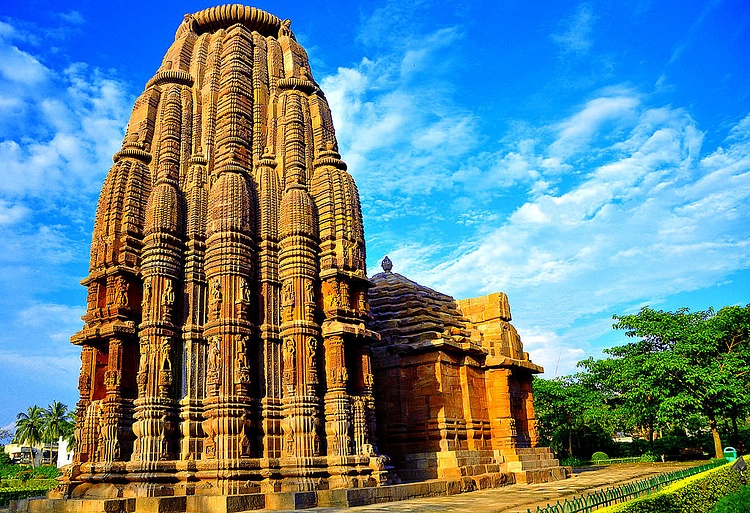
Bhubaneshwar (also spelt Bhubaneswar, Bhubanesar and Bhuvanesvar) is a city located in the Orissa district of north-eastern India and flourished as a centre of Hindu worship from the 7th century CE. Its mass of well-preserved sandstone temples, all oriented around the sacred lake Bindusarowar, make it one of the most impressive ancient temple sites in the whole of India.
ARCHITECTURAL HIGHLIGHTS
The Parasuramesvara & Other Early Temples
Orissan architecture greatly benefitted from a royal marriage between the Western Calukya rulers and Orissan royalty which brought to the region elements of Gupta architecture and its sophisticated temples. The Orissans then developed this canon into their own distinctive temple style. The oldest structures at Bhubaneswar are probably the three small Satrughnesvara shrines which are set in a line and date to perhaps the late 6th century CE.
The Parasuramesvara temple is of similar date, perhaps a little later, in the early 7th century CE, and built by the Shailodbhava kings. Dedicated to Shiva it has a sikhara (tower, also called deul in Orissan architecture) with a central projecting column on each face. It is topped with an usually large amalaka (ribbed circular stone). The rectangular mukhasala has, again unusually, an entrance at the front and side. The interior is lit with natural light from a row of small apertures in the roof and pierced stone screens. The temple is covered with decorative sculpture of palms, rosettes, and foliage, as well as statues, especially of Kartikeya and Ganesha.
Other early buildings at Bhubaneswar include the Svarnjalesvara, Gauri-Sankara, Mohini, Paschimesvara, and Uttaresvara temples. Two almost identical temples are the slightly later Markandesvara and Sisiresvara. Both have sculpture directly carved from the building stonework, as opposed to later temples when decorative sculpture was carved separately and added later.

Dancer, Vaital Deul, Bhubaneswar
The Vaital Deul
The squat Vaital Deul temple, used for tantric worship and dedicated to Chamunda, is located next to the Sisiresvara. The temple was built in the late 8th century CE under the Bhauma Kara kings. It has a two-columned entrance porch and a barrel-vaulted roof ( sala ) with three amalakas. It is the only structure at Bhubaneswar with figure sculpture in the interior of the garbhagriha (sacred shrine). Indicating the temple's connection with demons and ghosts, these sculptures show Shiva as fearsome Bhairava along with corpses and decapitated heads. The exterior has many kanyas figures – seductive female dancers employed in dressing and beautifying themselves – and a Shiva Nataraja.

Gateway, Muktesvara Temple, Bhubaneswar
The Muktesvara
Built in the 9th-10th century CE under the rule of the Sovamashi the red sandstone Muktesvara has a square entrance hall ( mandapa or jagamohana in Orissa temples) with a tiered ( pida ) roof. Above the sacred shrine is a tower or sikhara which has amalakas running up the four corners and topped by a single large example, as is typical in Hindu temples across India. On top of the amalaka is a decorative element known as a khapuris, a flat bell-shaped adornment which is topped by either a trident or linga. The tower is punctuated in the middle of each face by protruding crouching lions ( dopicchas ).
The temple is decorated on the exterior with figures of kanyas, ascetics, and demons all set in individual frames of dots and foliage. Untypically, the ceiling of the mandapa has relief carvings which depict the mythical warrior Virabhadra and the Seven Mothers. The entire building is surrounded by a low wall or parapet carved in relief which has a single ornate gateway with two columns supporting an intricately carved arch. The temple is the greatest example of the mature Orissan architectural style.
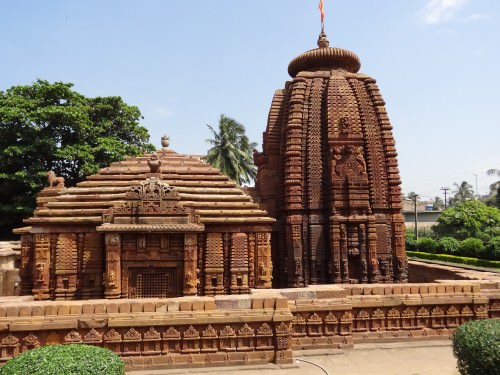
Muktesvara Temple, Bhubaneswar
The Lingaraja
Built around 1100 CE in the reign of the Ganga kings the massive Lingaraja temple was originally known as the Tribhuvanesvara or the Lord of the Three Worlds, one of the many guises of Shiva. The main temple is composed of four connected chambers: the sacred shrine ( deul ), entrance hall ( jagamohana ), dance hall ( nata-mandira ), and offerings hall ( bhoga-mandira ). Each supports its own ceiling with four massive pillars. The tower is 45 metres high and even the jagamohana rises an impressive 30 metres. The latter also has two windows with balustrades. Decorative sculpture on the building exteriors includes Yama and Indra in their role as dikpalas (cardinal directions), Ganesha, Parvati, vyalas stamping on elephants, friezes of military episodes, and a multitude of kanyas. The walled compound also contains many subsidiary shrines.
The Rajarani & Other Later Temples
The Rajarani temple was constructed in the 11th to 12th centuries CE in the reign of the Somavamshis on a diamond plan.Similar to temples at Khajuraho, the tower is surrounded by many smaller towers of different heights creating a mass of rising curves. The lower part of the tower is decorated with sculpture of all eight dikpalas (a rarity) and various female figures.
The Brahmesvara was constructed in c. 1061 CE and helps to date the Lingaraja on stylistic grounds. The Ananta Vasudeva was built in 1275 CE and is the only major temple at the site which is dedicated to Vishnu. Finally, the Meghesvara was erected in the final quarter of the 12th century CE and has an unusually curved tower.
Magic in Ancient Egypt › Origins
Ancient Civilizations
In ancient Egypt, if a woman were having difficulty conceiving a child, she might spend an evening in a Bes Chamber (also known as an incubation chamber) located within a temple. Bes was the god of childbirth, sexuality, fertility, among other his other responsibilities, and it was thought an evening in the god's presence would encourage conception. Women would carry Bes amulets, wear Bes tattoos, in an effort to encourage fertility.
Once a child was born, Bes images and amulets were used in protection as he or she grew and, later, the child would become an adult who adopted these same rituals and beliefs in daily life. At death, the person was thought to move on to another plane of existence, the land of the gods, and the rituals surrounding burial were based on the same understanding one had known all of one's life: that supernatural powers were as real as any other aspect of existence and the universe was infused by magic.
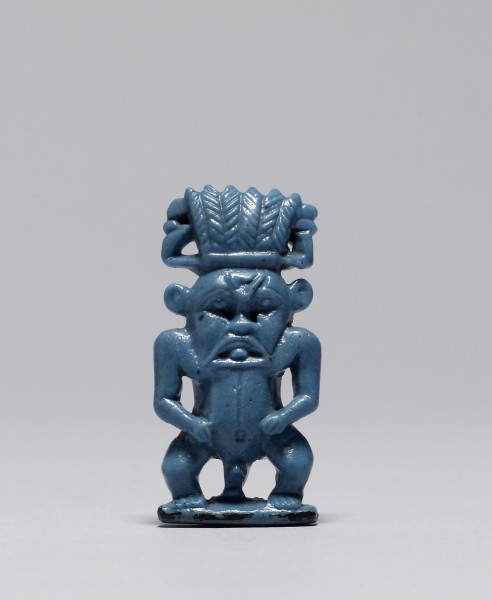
Bes Amulet
Magic in ancient Egypt was not a parlor trick or illusion; it was the harnessing of the powers of natural laws, conceived of as supernatural entities, in order to achieve a certain goal. To the Egyptians, a world without magic was inconceivable. It was through magic that the world had been created, magic sustained the world daily, magic healed when one was sick, gave when one had nothing, and assured one of eternal life after death. The Egyptologist James Henry Breasted has famously remarked how magic infused every aspect of ancient Egyptian life and was "as much a matter of course as sleep or the preparation of food" (200). Magic was present in one's conception, birth, life, death, and afterlife and was represented by a god who was older than creation: Heka.
MAGIC SUSTAINED THE WORLD DAILY, MAGIC HEALED WHEN ONE WAS SICK, GAVE WHEN ONE HAD NOTHING, & ASSURED ONE OF ETERNAL LIFE AFTER DEATH.
HEKA
Heka was the god of magic and the practice of the art itself. A magician-priest or priest-physician would invoke Heka in the practice of heka. The god was known as early as the Pre-Dynastic period (c. 6000-c. 3150 BCE), developed during the Early Dynastic Period (c. 3150-c. 2613 BCE) and appears in The Pyramid Texts of the Old Kingdom (c. 2613-2181 BCE) and the Coffin Texts of the First Intermediate Period (2181-2040 BCE). Heka never had a temple, cult following, or formal worship for the simple reason that he was so all-pervasive he permeated every area of Egyptian life.
Like the goddess Ma'at, who also never had a formal cult or temple, Heka was considered the underlying force of the visible and invisible world. Ma'at represented the central Egyptian value of balance and harmony while Heka was the power which made balance, harmony, and every other concept or aspect of life possible. In the Coffin Texts, Heka claims this primordial power stating, "To me belonged the universe before you gods came into being. You have come afterwards because I am Heka" (Spell 261). After creation, Heka sustained the world as the power which gave the gods their abilities. Even the gods feared him and, in the words of Egyptologist Richard H. Wilkinson, "he was viewed as a god of inestimable power" (110). This power was evident in one's daily life: the world operated as it did because of the gods and the gods were able to perform their duties because of Heka.
MAGIC & RELIGION
The priests of the temple cults understood this but their function was to honor and care for their particular deity and ensure a reciprocity between that god and the people. The priests or priestesses, therefore, would not invoke Heka directly because he was already present in the power of the deity they served.
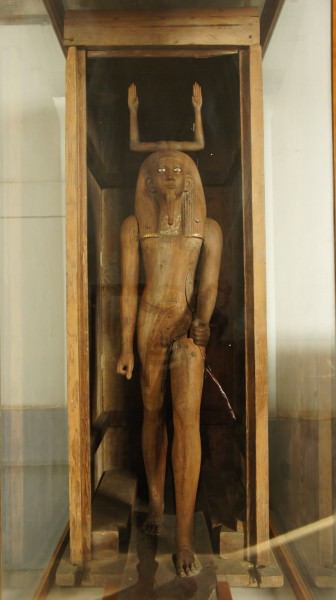
Heka
Magic in religious practice took the form of establishing what was already known about the gods and how the world worked. In the words of Egyptologist Jan Assman, the rituals of the temple "predominantly aimed at maintenance and stability" (4).Egyptologist Margaret Bunson clarifies:
The main function of priests appears to have remained constant; they kept the temple and sanctuary areas pure, conducted the cultic rituals and observances, and performed the great festival ceremonies for the public. (208)
In their role as defenders of the faith, they were also expected to be able to display the power of their god against those of any other nation. A famous example of this is given in the biblical book of Exodus (7:10-12) when Moses and Aaron confront the Egyptian "wise men and sorcerors".
The priest was the intermediary between the gods and the people but, in daily life, individuals could commune with the gods through their own private practices. Whatever other duties the priest engaged in, as Assman points out, his primary importance was in imparting to people theological meaning through mythological narratives. They might offer counsel or advice or material goods but, in cases of sickness or injury or mental illness, another professional was consulted: the physician.
MAGIC & MEDICINE
Heka was the god of medicine as well as magic and for good reason: the two were considered equally important by medical professionals. There was a kind of doctor with the title of swnw (general practitioner) and another known as a sau (magical practitioner) denoting their respective areas of expertise but magic was widely used by both. Doctors operated out of an institution known as the Per- Ankh ("The House of Life"), a part of a temple where medical texts were written, copied, studied, and discussed.
The medical texts of ancient Egypt contain spells as well as what one today would consider 'practical measures' in treating disease and injury. Disease was considered supernatural in origin throughout Egypt's history even though the architect Imhotep (c. 2667-2600 BCE) had written medical treatises explaining that disease could occur naturally and was not necessarily a punishment sent by the gods.

Papyrus Chester Beatty VI
The priest-physician-magician would carefully examine and question a patient to determine the nature of the problem and would then invoke whatever god seemed most appropriate to deal with it. Disease was a disruption of the natural order and so, unlike the role of the temple priest who maintained the people's belief in the gods through standard rituals, the physician was dealing with powerful and unpredictable forces which had to be summoned and controlled expertly.
Doctors, even in rural villages, were expensive and so people often sought medical assistance from someone who might have once worked with a doctor or had acquired some medical knowledge in some other way. These individuals seem to have regularly set broken bones or prescribed herbal remedies but would not have been thought authorized to invoke a spell for healing. That would have been the official view on the subject, however; it seems a number of people who were not considered doctors still practiced medicine of a sort through magical means.
MAGIC IN DAILY LIFE
Among these were the seers, wise women who could see the future and were also instrumental in healing. Egyptologist Rosalie David notes how, "it has been suggested that such seers may have been a regular aspect of practical religion in the New Kingdom and possibly even in earlier times" (281). Seers could help women conceive, interpret dreams, and prescribed herbal remedies for diseases. Although the majority of Egyptians were illiterate, it seems some people - like the seers - could memorize spells read to them for later use.

Egyptian Protective Knife
Egyptians of every social class from the king to the peasant believed in and relied upon magic in their daily lives. Evidence for this practice comes from the number of amulets and charms found through excavations, inscriptions on obelisks, monuments, palaces, and temples, tomb engravings, personal and official correspondence, inscriptions, and grave goods. Rosalie David explains that "magic had been given by the gods to mankind as a means of self-defense and this could be exercised by the king or by magicians who effectively took on the role of the gods" (283). When a king, magician, or doctor was unavailable, however, everyday people performed their own rituals.
Charms and spells were used to increase fertility, for luck in business, for improved health, and also to curse an enemy. One's name was considered one's identity but Egyptians believed that everyone also had a secret name (the ren ) which only the individual and the gods knew. To discover one's secret name was to gain power over them. Even if one could not discover another person's ren they could still exercise control by slandering the person's name or even erasing that person's name from history.
MAGIC IN DEATH
Just as magic was involved in one's birth and life, so was it present at one's departure to the next world. Mummification was practiced in order to preserve the body so that it could be recognized by the soul in the afterlife. The last act of the priests at a funeral was the Opening of the Mouth Ceremony during which they would touch the mummified corpse with different objects at various places on the body in order to restore the use of ears, eyes, mouth, and nose. Through this magical ritual the departed would be able to see and hear, smell and taste, and speak in the afterlife.
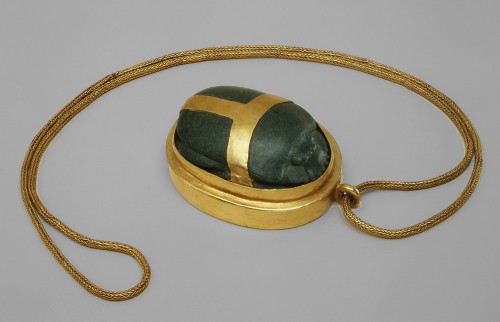
Heart Scarab of Hatnefer
Amulets were wrapped with the mummy for protection and grave goods were included in the tomb to help the departed soul in the next world. Many grave goods were practical items or favorite objects they had enjoyed in life but many others were magical charms or objects which could be called upon for assistance.
The best known of these type were the shabti dolls. These were figures made of faience or wood or any other kind of material which sometimes looked like the deceased. Since the afterlife was considered a continuation of one's earthly life, the shabti could be called upon to work for one in The Field of Reeds. Spell 472 of the Coffin Texts (repeated later as Spell 6 of The Egyptian Book of the Dead ) is given to bring the Shabti to life when one needs to so one can continue to enjoy the afterlife without worrying about work.
The Egyptian Book of the Dead exemplifies the belief in magic at work in the afterlife. The text contains 190 spells to help the soul navigate the afterlife to reach the paradise of The Field of Reeds, an eternal paradise which perfectly reflected one's life on earth but without disappointment, disease or the fear of death and loss. Throughout The Egyptian Book of the Dead the soul is instructed which spells to use to pass across certain rooms, enter doors, transform one's self into different animals to escape dangers, and how to answer the questions of the gods and those of their realm. All of these spells would have seemed as natural to an ancient Egyptian as detailed directions on a map would be to anyone today - and just as reasonable.
CONCLUSION
It may seem strange to a modern mind to equate magical solutions with reason but this is simply because, today, one has grown used to a completely different paradigm than the one which prevailed in ancient Egypt. This does not mean, however, that their understanding was misguided or `primitive' and the present one is sophisticated and correct. In the present, one believes that the model of the world and the universe collectively recognized as 'true' is the best model possible precisely because it is true. According to this understanding, beliefs which differ from one's truth must be wrong but this is not necessarily so.
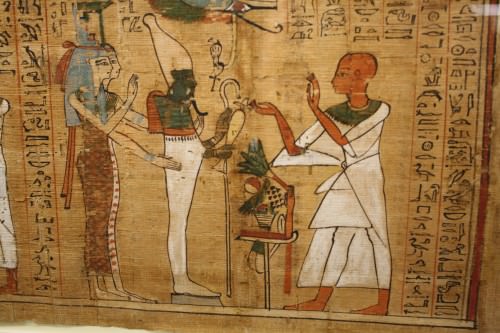
Book of the Dead of Aaneru
The scholar CS Lewis is best known for his fantasy works about the land of Narnia but he wrote many other books and articles on literature, society, religion, and culture. In his book The Discarded Image, Lewis argues that societies do not dismiss the old paradigms because the new ones are found to be more true but because the old belief system no longer suits a society's needs. The prevailing beliefs of the modern world which people consider more advanced than those of the past are not necessarily more true but only more acceptable. People in the present day accept these concepts as true because they fit their model of how the world works.
This was precisely the same way in which the ancient Egyptians saw their world. The model of the world as they understood it contained magic as an essential element and this was completely reasonable to them. All of life had come from the gods and these gods were not distant beings but friends and neighbors who inhabited the temple in the city, the trees by the stream, the river which gave life, the fields one plowed. Every civilization in any given era believes that it knows and operates on the basis of truth; if they did not, they would change.
When the model of the world changed for ancient Egypt c. 4th century CE - from a henotheistic/polytheistic understanding to the monotheism of Christianity - their understanding of 'truth' also changed and the kind of magic they recognized as imbuing their lives was exchanged for a new pardigm which fit their new understanding. This does not mean that new understanding was correct or more 'true' than what they had believed in for millenia; merely that it was now more acceptable.
See other Related Content for Ancient History ››
LICENSE
Article based on information obtained from these sources:with permission from the Website Ancient History Encyclopedia
Content is available under License Creative Commons: Attribution-NonCommercial-ShareAlike 3.0 Unported. CC-BY-NC-SA License